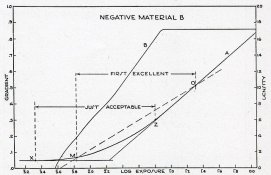Bill and Stephen Benskin
The system you are practicing is important in scientifical study of the Film.
Your densitometer cell is different than the cell on your Lightmeter. You pack the densitometer and set the Film-speed on the LightMeter be it handheld or in the Camera. This leads to an error due to reading from different cell. Seconic shows different reading from Gossen, different from Minolta, … Even from Gossen to Gossen is different. There are no two identical cells.
The point is to use the same Photo-cell throughout the process, and the same (well close enough) Light temperature during the test and your Photography, and make correction when you sniff the Light temperature change. Film speed is not the same at evening and noon and at the room-bulb Light. The difference can be two times.
What you do is better than nothing, but it is by far not the best system in practical Photography.
I have Kodak grey card which shows 14 Zones, some use I … IX, some 0…X and so on.
Zone system is invented and is good starting point. It is just so confusable when one says Zone I. What that means to one that made the Kodak grey card and to you is different.
Another think is you work with two decimal places (e.g. 7.25). How you set it on the Lens? How you set on the camera Film speed iso148.96? Here your accuracy is gone. The next error is water for your developer which WILL change chemical composition of the developer. The next is the thermometer, and do you think that all thermometers shows exactly the same temperature? The next think is the broken liquid in the thermometer and you did not notice it so you read 20 deg.C but actually is 21 deg.C, and so on and so on.
All of this just remains me on Jansen’s comment (an art historian): “… they make so large paintings that the size itself only matters, but what happens when that art is shown in illustrations for showing it …?”
You are knowledgeable guy and should concentrate on one new system in Photography, and it is using the same LightMeter for
1. Film exposure during the Film testing
2. reading film densities
3. testing Photo papers
4. during enlargement
5. for exposure reading to set the Camera
And if you want, get a cheap Gossen sixtycolour-colourMeter.
NOW when you assign 0.1 density to 3 F-stops below 18% shot, and when in field and you read from the darkest part and close aperture 3 F-stops you know: it will appear close to 0.1 density on your Film (CLOSE because there are variables you just cannot control 100%, as developer concentration, water, temperature, agitation, Lens aperture accuracy, … The more elements you have in the system the LOWER accuracy is, just opposite of what you expect.
This is where you should concentrate your energy. No oil there where you dig now. Still there are sooooo many things to discover in Photography
Good luck






